Wide-Field-of-View Longwave Camera for the Characterization of the Earth’s Outgoing Longwave Radiation
Abstract
:1. Introduction
2. Optical System Design
2.1. Scientific and Technical Requirements
- (1)
- The Earth should be seen from limb to limb, from a nominal satellite altitude of 700 km.
- (2)
- The camera should enable scene identification.
- (3)
- The camera should measure LW radiation, allowing to reconstruct the OLR on a stand-alone basis with an error of maximally 5%, as stated in [8].
- (4)
- At nadir, the camera should have a resolution of 5 km or better.
- (5)
- The volume of the camera (optics and detector) should fit within 1 CubseSat Unit (1U).
- (6)
- The optical system should be designed with a minimal amount of optical elements and optical materials, in order to limit the cost and ease the fabrication.
2.2. Optical Design of the LW Camera
3. Remote Sensing of the Outgoing Longwave Radiation
- Simulations of the spectral brightness temperatures, in libRadtran;
- Computation of the spectral irradiances;
- Computation of the broadband temperature;
- Computation of the narrowband temperature;
- Fit of the broadband temperature as function of the narrowband temperature;
- Estimation of the OLR and calculation of the error on the OLR.
3.1. Simulations of Spectral Brightness Temperatures
3.2. Computation of the Spectral Irradiances
3.3. Computation of the Broadband Temperatures
3.4. Computation of the Narrowband Temperatures
3.5. Fit of the Broadband Temperature as Function of the Narrowband Temperature
3.6. Estimation of the OLR and Calculation of Error on OLR
4. Discussion
5. Conclusions
Author Contributions
Funding
Acknowledgments
Conflicts of Interest
Abbreviations
| 1U | 1 CubeSat Unit |
| ADM | Angular Distribution Models |
| CERES | Clouds and the Earth’s Radiant Energy System |
| COTS | Commercial Off-The-Shelf |
| EEI | Earth’s Energy Imbalance |
| ERB | Earth’s Radiation Budget |
| FOV | Field Of View |
| IMA | IMAge |
| LW | LongWave |
| MTF | Modulation Transfer Function |
| NASA | National Aeronautics and Space Administration |
| OBJ | OBJect |
| OLR | Outgoing Longwave Radiation |
| RMS | Root Mean Square |
| RMSE | Root-Mean-Square Error |
| RSR | Reflected Solar Radiation |
| RTE | Radiative Transfer Equation |
| SIMBA | Sun-earth IMBAlance |
| SW | ShortWave |
| TOA | Top-Of-Atmosphere |
| TRMM | Tropical Rainfall Measuring Mission |
| WFOV | Wide-Field-Of-View |
References
- Dewitte, S.; Clerbaux, N. Measurement of the Earth Radiation Budget at the Top of the Atmosphere—A Review. Remote Sens. 2017, 9, 1143. [Google Scholar] [CrossRef] [Green Version]
- Wielicki, B.A.; Barkstrom, B.R.; Harrison, E.F.; Lee, R.B., III; Smith, G.L.; Cooper, J.E. Clouds and the Earth’s Radiant Energy System (CERES): An Earth observing system experiment. BAMS 1996, 77, 853–868. [Google Scholar] [CrossRef] [Green Version]
- Loeb, N.G.; Doelling, D.R. Clouds and the earth’s radiant energy system (CERES) energy balanced and filled (EBAF) top-of-atmosphere (TOA) edition-4.0 data product. J. Clim. 2018, 31, 895–918. [Google Scholar] [CrossRef]
- Loeb, N.; Smith, N.M.; Kato, S.; Miller, W.F.; Gupta, S.K.; Minnis, P.; Wielicki, B. Angular Distribution Models for TOA radiative flux estimation from the CERES instrument on the TRMM satellite. Part 1: Methodology. JAM 2002, 42, 240–265. [Google Scholar]
- Ackerman, S.A.; Holz, R.E.; Frey, R. Cloud Detection with MODIS. Part II: Validation. Am. Meteorol. Soc. 2008, 25, 1073–1086. [Google Scholar] [CrossRef] [Green Version]
- Pilewskie, P. Libera and Continuity of the ERB Climate Data Record; American Geophysical Union: Washington, DC, USA, 2020. [Google Scholar]
- Earth Venture Continuity Radiation Budget Science Working Group. Measurement and Instrument Requirement Recommendations for an Earth Venture Continuity Earth Radiation Budget Instrument. 2018. Available online: https://smd-prod.s3.amazonaws.com/science-pink/s3fs-public/atoms/files/ERB_SWG_Rept_Draft_07242018_TAGGED.pdf (accessed on 14 May 2020).
- Schifano, L.; Smeesters, L.; Geernaert, T.; Berghmans, F.; Dewitte, S. Design and analysis of a next generation wide field-of-view Earth Radiation Budget radiometer. Remote Sens. 2020, 12, 425. [Google Scholar] [CrossRef] [Green Version]
- Hansen, J.; Sato, M.; Kharecha, P.; von Schuckmann, K. Earth’s energy imbalance and implications. Atmos. Chem. Phys. 2011, 11, 13421–13449. [Google Scholar] [CrossRef] [Green Version]
- Trenberth, K.E.; Fasullo, J.T.; von Schuckmann, K.; Cheng, L. Insights into Earth’s Energy Imbalance from Multiple Sources. J. Clim. 2016, 29, 7495–7505. [Google Scholar] [CrossRef]
- von Schuckmann, K.; Palmer, M.D.; Trenberth, K.E.; Cazenave, A.; Chambers, D.; Champollion, N.; Hansen, J.; Josey, S.A.; Loeb, N.; Mathieu, P.-P.; et al. An imperative to monitor Earth’s energy imbalance. Nat. Clim Chang. 2016, 6, 138–144. [Google Scholar] [CrossRef] [Green Version]
- Schifano, L.; Smeesters, L.; Berghmans, F.; Dewitte, S. Optical system design of a wide field-of-view camera for the characterization of earth’s reflected solar radiation. Remote Sens. 2020, 12, 2556. [Google Scholar] [CrossRef]
- Del Pozo, S.; Sáez Blázquez, C.; Martín Nieto, I.; Lagüela, S. Integrated Approach for Detecting Convection Effects in Geothermal Environments Based on TIR Camera Measurements. Appl. Sci. 2021, 11, 3185. [Google Scholar] [CrossRef]
- Qiu, R.; Dou, W.; Kan, J.; Yu, K. Optical design of wide-angle lens for LWIR earth sensors. In Proceedings of the SPIE 10209, Image Sensing Technologies: Materials, Devices, Systems, and Applications IV, Anaheim, CA, USA, 12–13 April 2017; p. 102090T. [Google Scholar]
- Zhu, C.; Hobbs, M.J.; Grainger, M.P.; Willmott, J.R. Design and realization of a wide field of view infrared scanning system with an integrated micro-electromechanical system mirror. Appl. Opt. 2018, 57, 10449–10457. [Google Scholar] [CrossRef] [PubMed]
- Infante Herrero, J.M.; Muñoz, F.; Benitez, P.; Miñano, J.C.; Wang, L.; Vilaplana, J.; Biot, G.; de La Fuente, M. Novel fast catadioptric objective with wide field of view. In Proceedings of the SPIE 7787, Novel Optical Systems Design and Optimization XIII, San Diego, CA, USA, 27 August 2010; p. 778704. [Google Scholar]
- SCHOTT® Website. Available online: https://www.schott.com/ (accessed on 12 May 2020).
- Normanshire, C. Designing for As-Built Performance with High-Yield Optimization; MyZemax: Seattle, WA, USA, 2020; KA-01837. [Google Scholar]
- Riedl, M.J. Seidel and the Pegel Diagrams. In Optical Design: Applying the Fundamentals; SPIE Press: Bellingham, WA, USA, 2009. [Google Scholar]
- Mayer, B.; Emde, C.; Buras-Schnell, R.; Kylling, A. Radiative transfer: Methods and applications. In Atmospheric Physics; Springer: Berlin/Heidelberg, Germany, 2012; pp. 401–415. [Google Scholar]
- Anderson, G.; Clough, S.; Kneizys, F.; Chetwynd, J.; Shettle, E. AFGL Atmospheric Constituent Profiles (0–120 km); Tech. Rep. AFGL-TR-86-0110; Air Force Geophysics Laboratory, Air Force Systems Command, United States Air Force: Hanscom AFB, MA, USA, 1986; p. 10294. [Google Scholar]
- Kittel, C.; Kroemer, H. Thermal Physics; W.H. Freeman and Company: New York, NY, USA, 1980. [Google Scholar]
- Mayer, B.; Kylling, A.; Emde, C.; Buras, R.; Hamann, U.; Gasteiger, J.; Richter, B. libRadtran User’s Guide. 2020. Available online: http://www.libradtran.org/doc/libRadtran.pdf (accessed on 2 February 2021).
- Emde, C.; Buras-Schnell, R.; Kylling, A.; Mayer, B.; Gasteiger, J.; Hamann, U.; Kylling, J.; Richter, B.; Pause, C.; Dowling, T.; et al. The libRadtran software package for radiative transfer calculations (version 2.0.1). Geosci. Model Dev. 2016, 9, 1647–1672. [Google Scholar] [CrossRef] [Green Version]
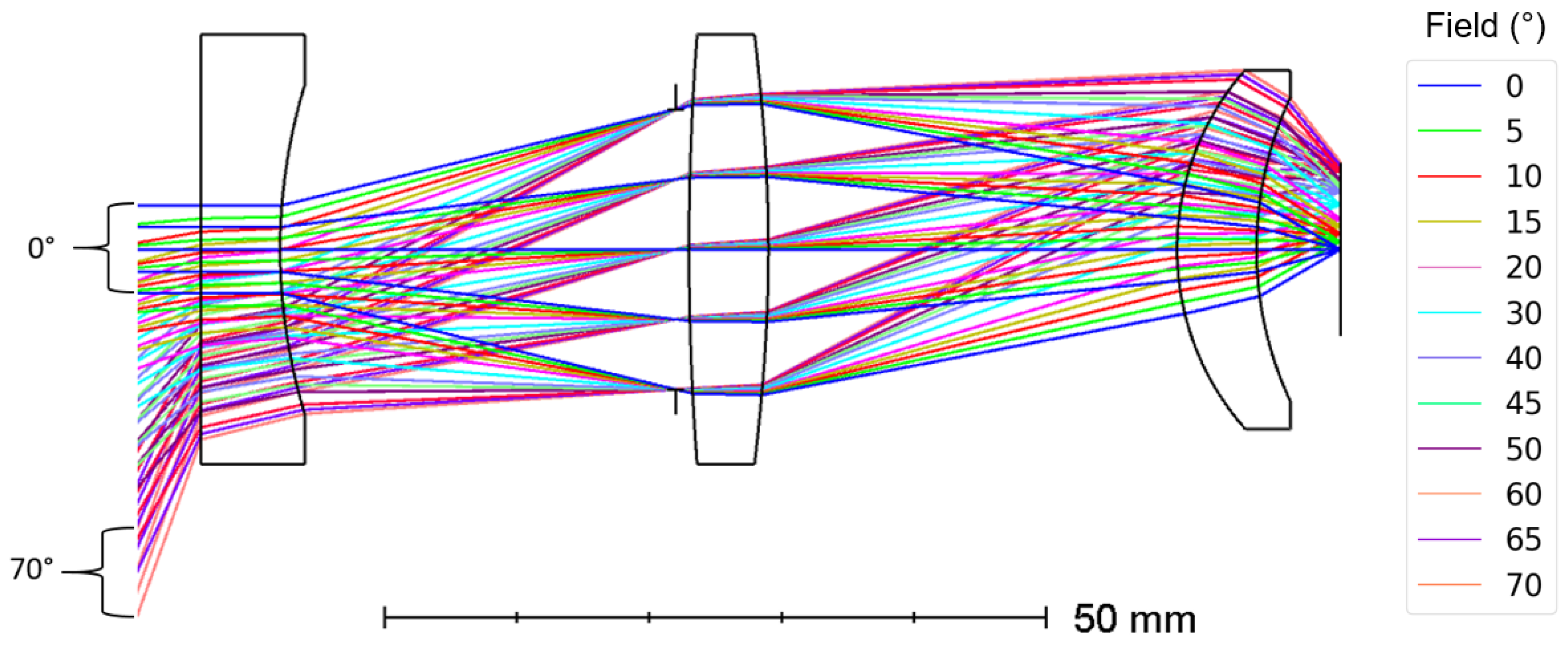

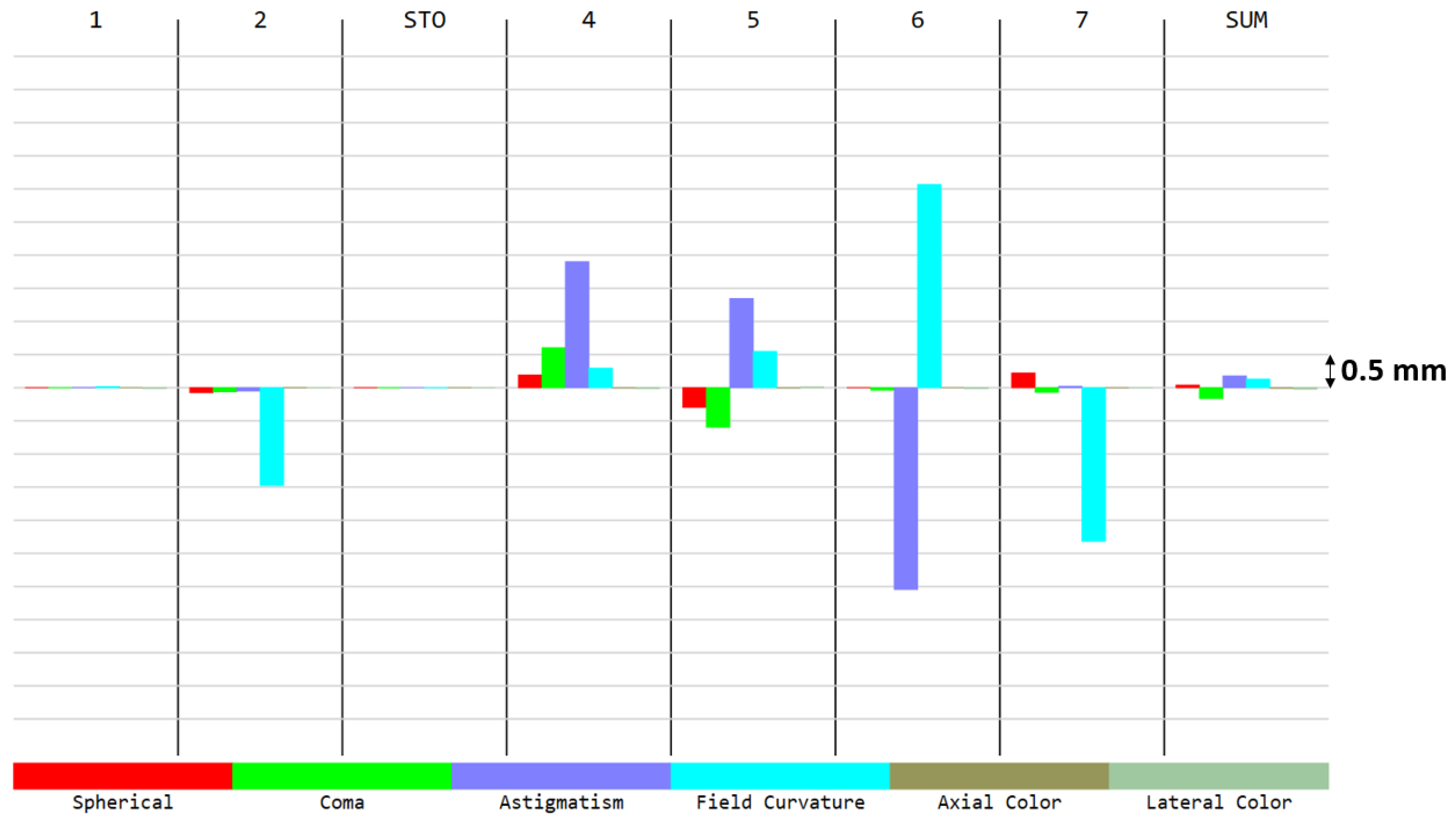
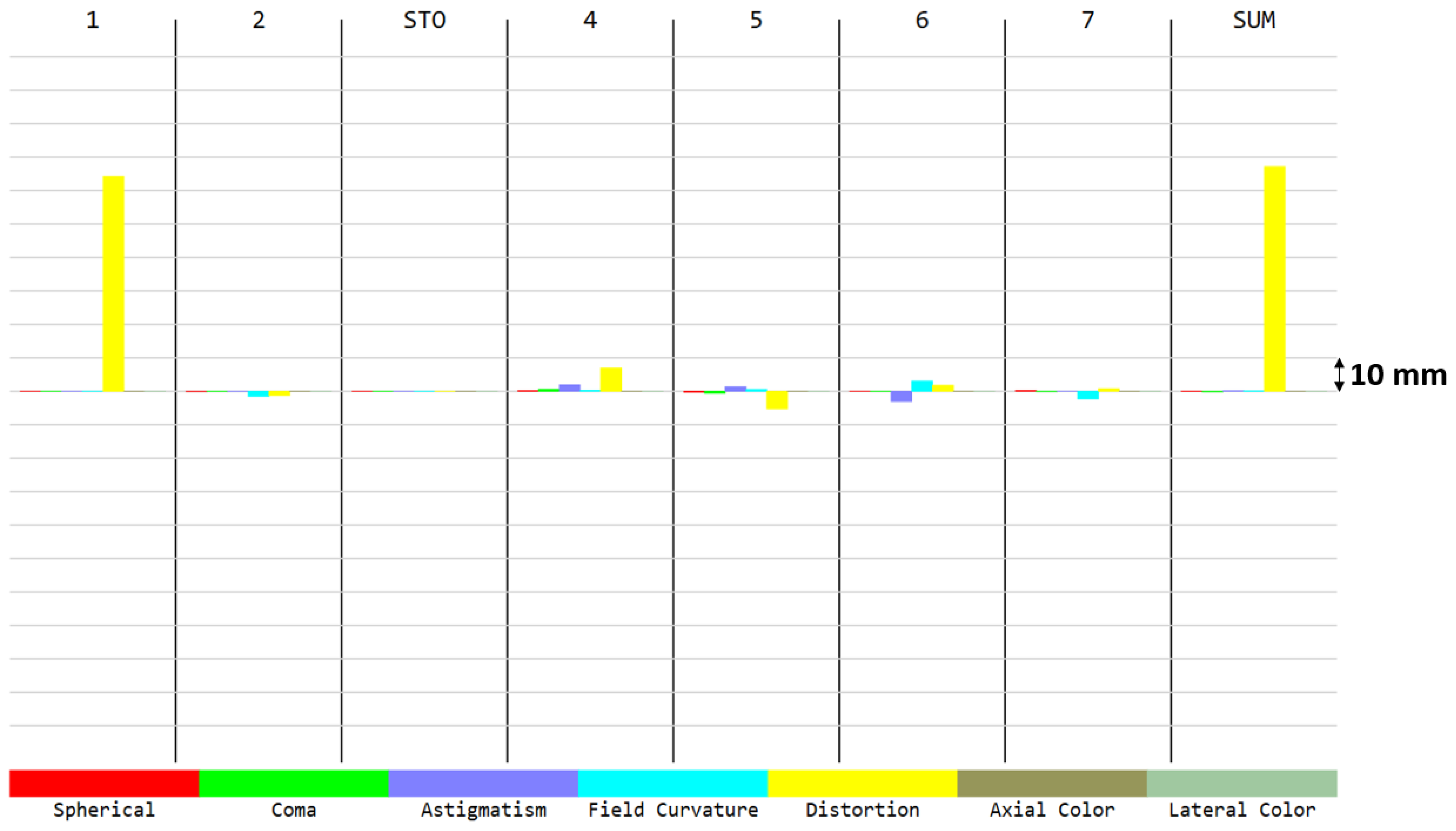
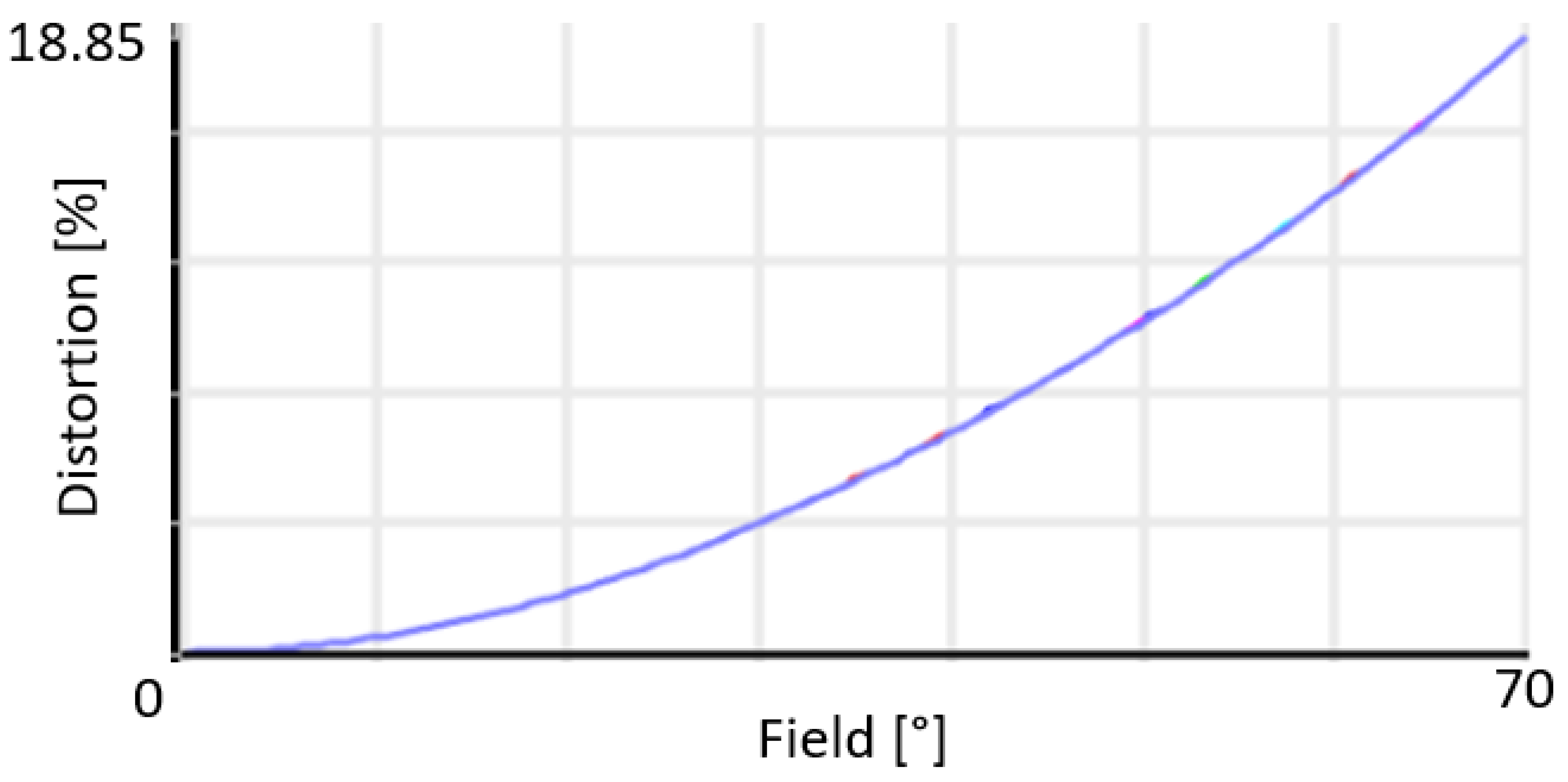
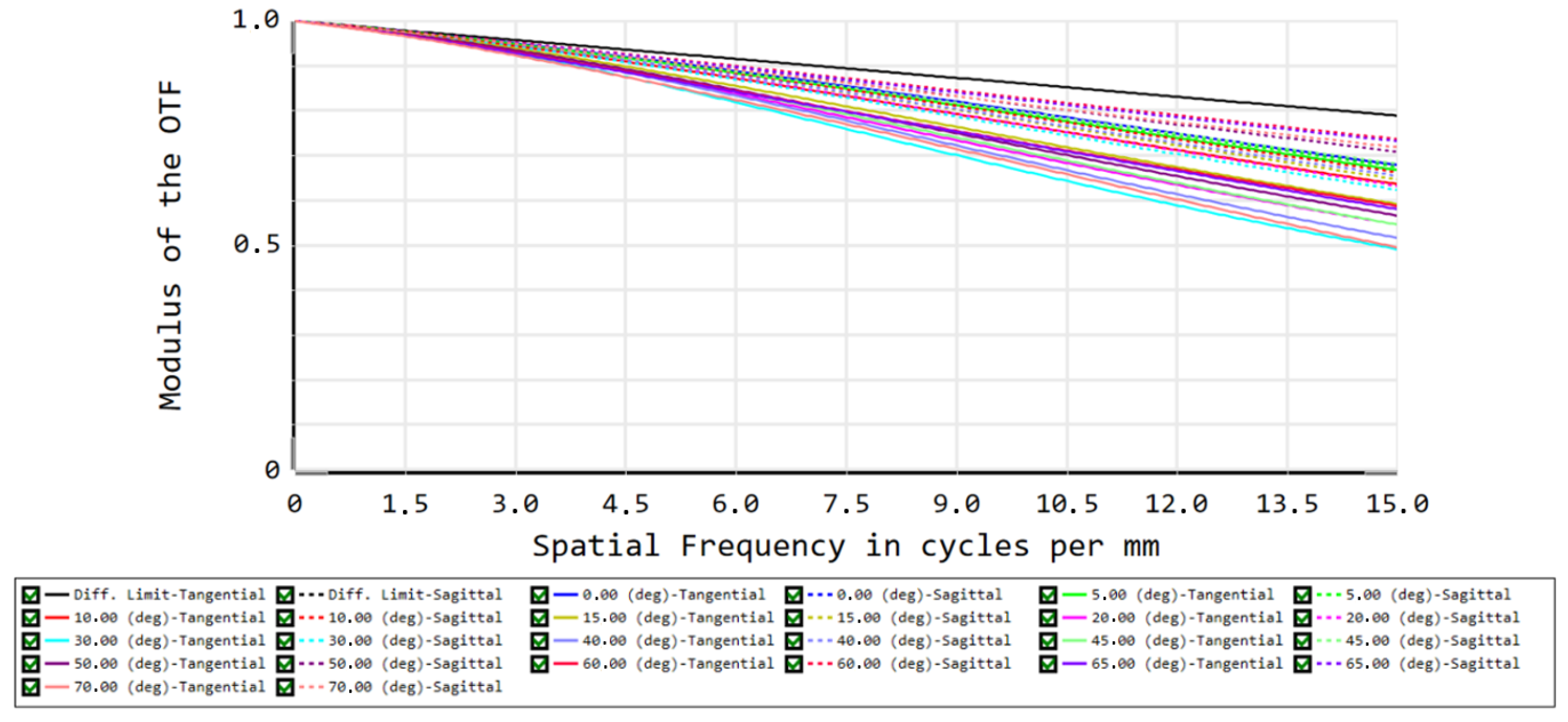

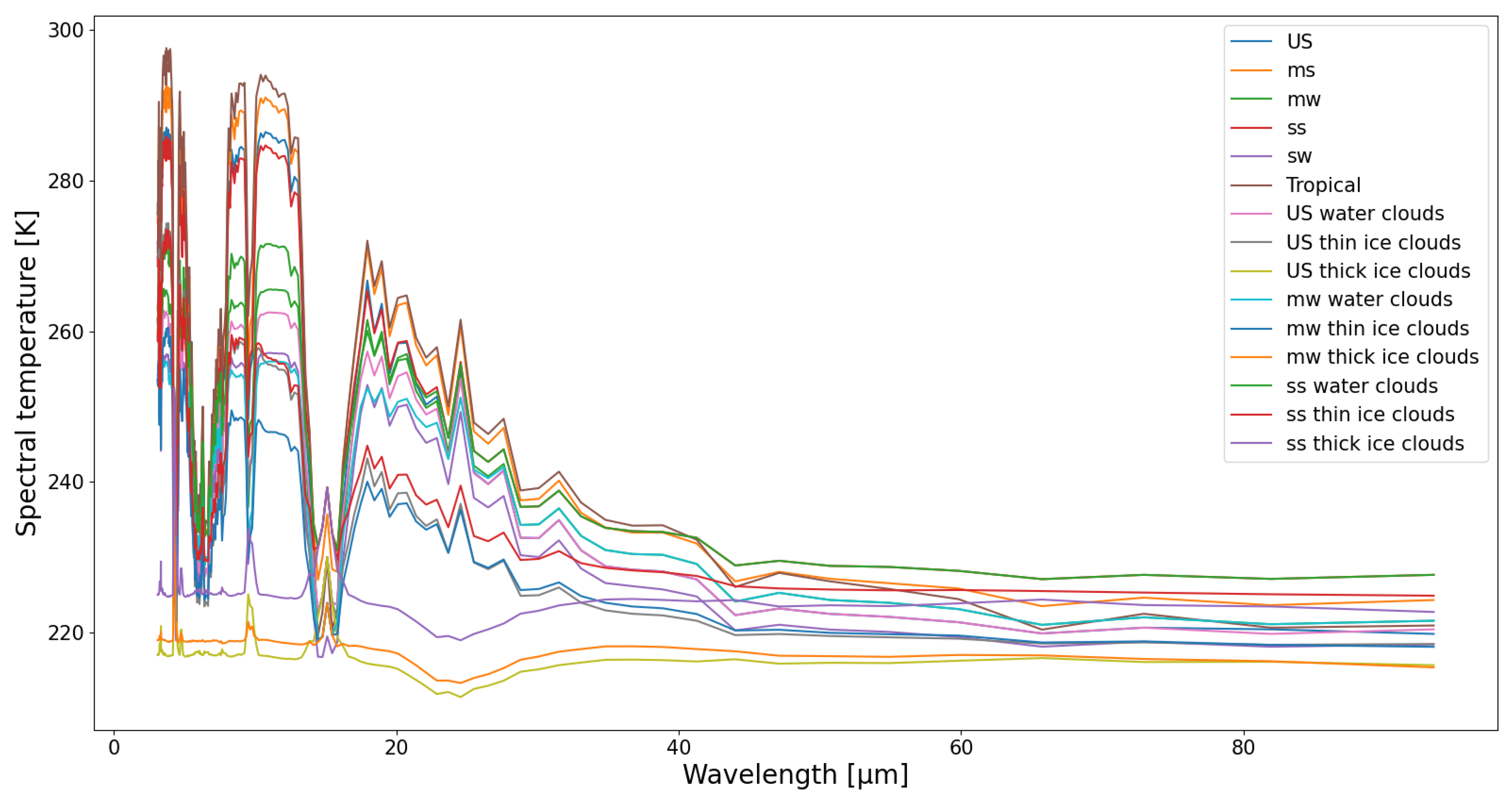
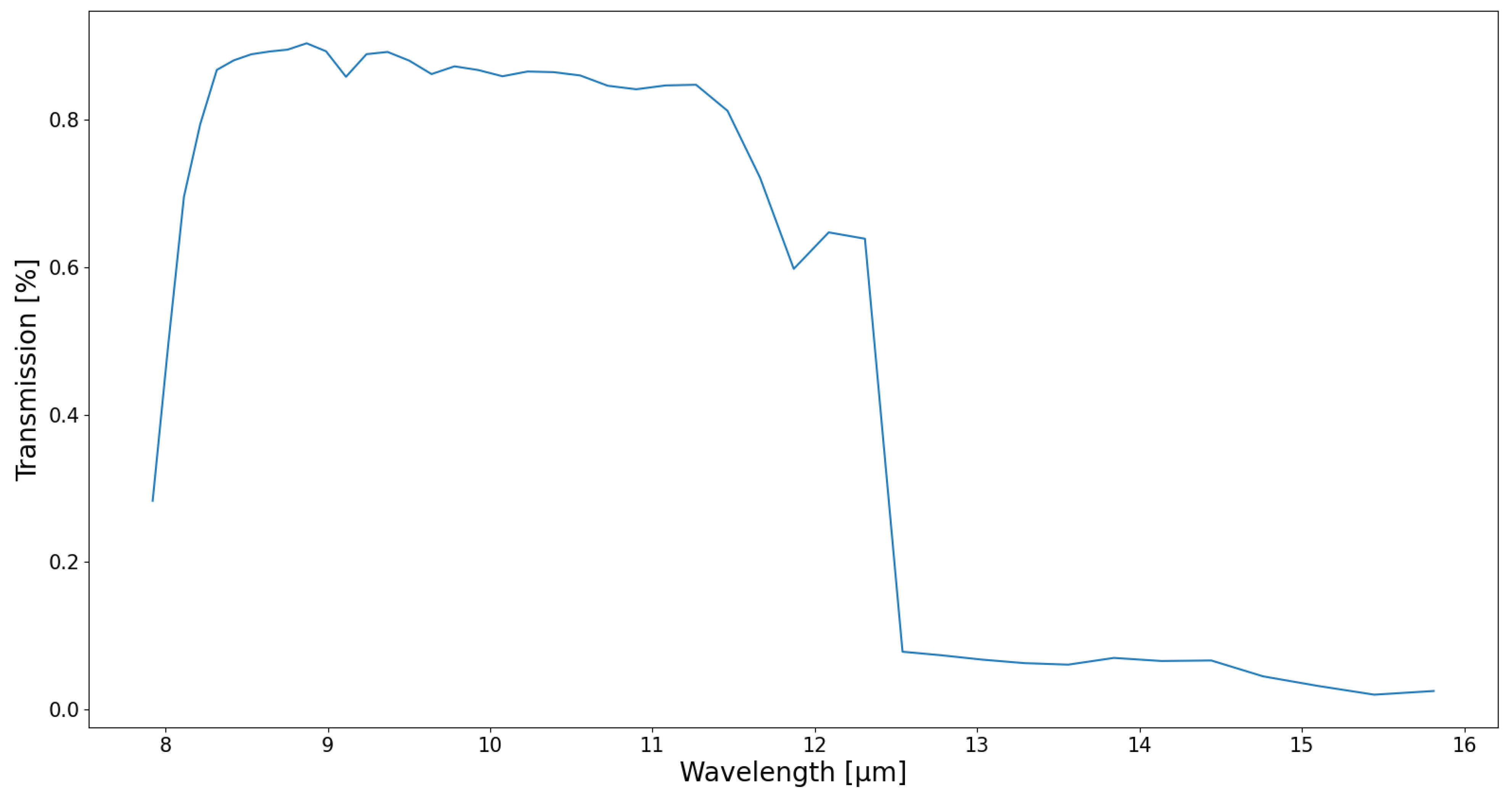
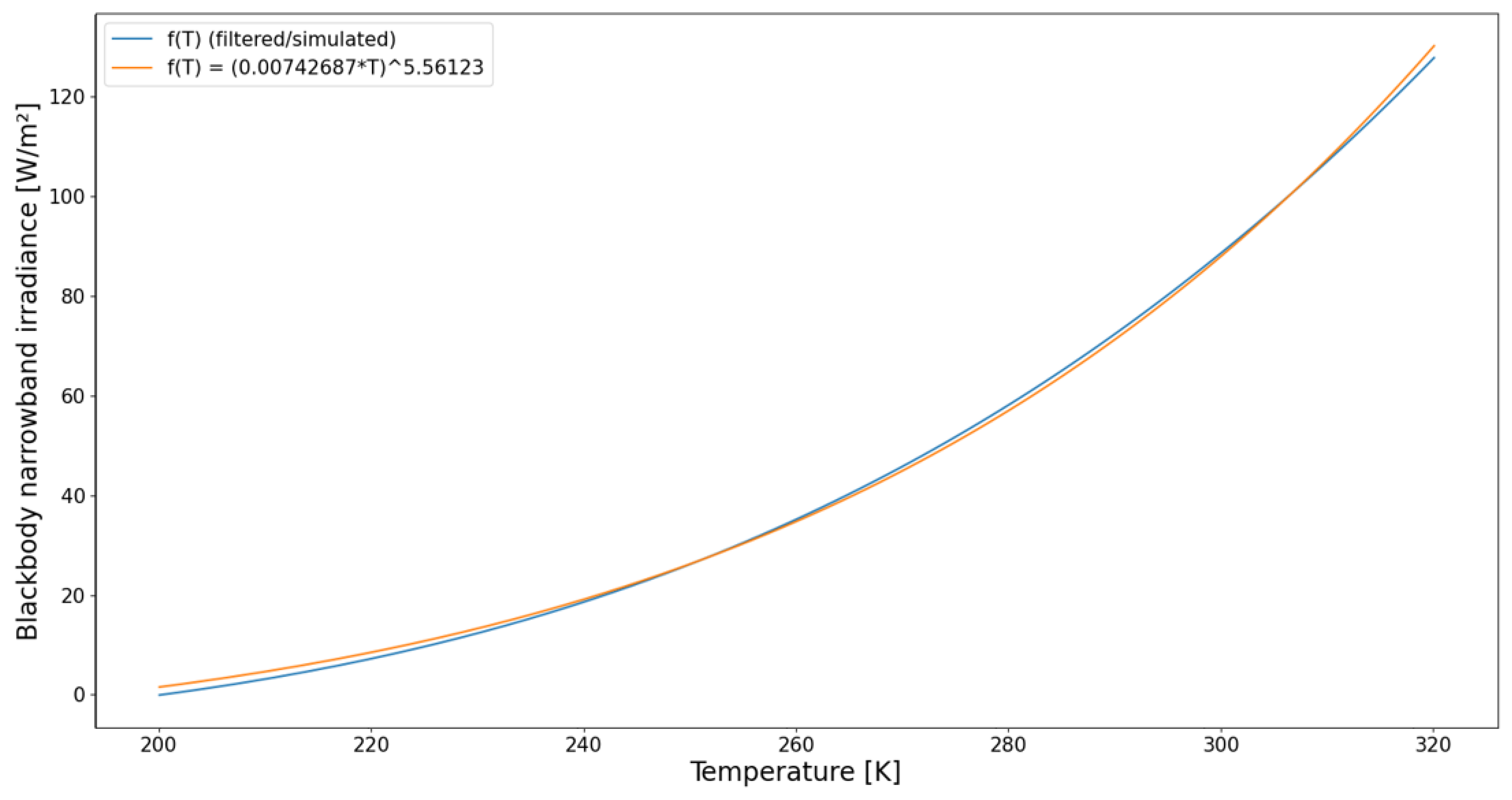
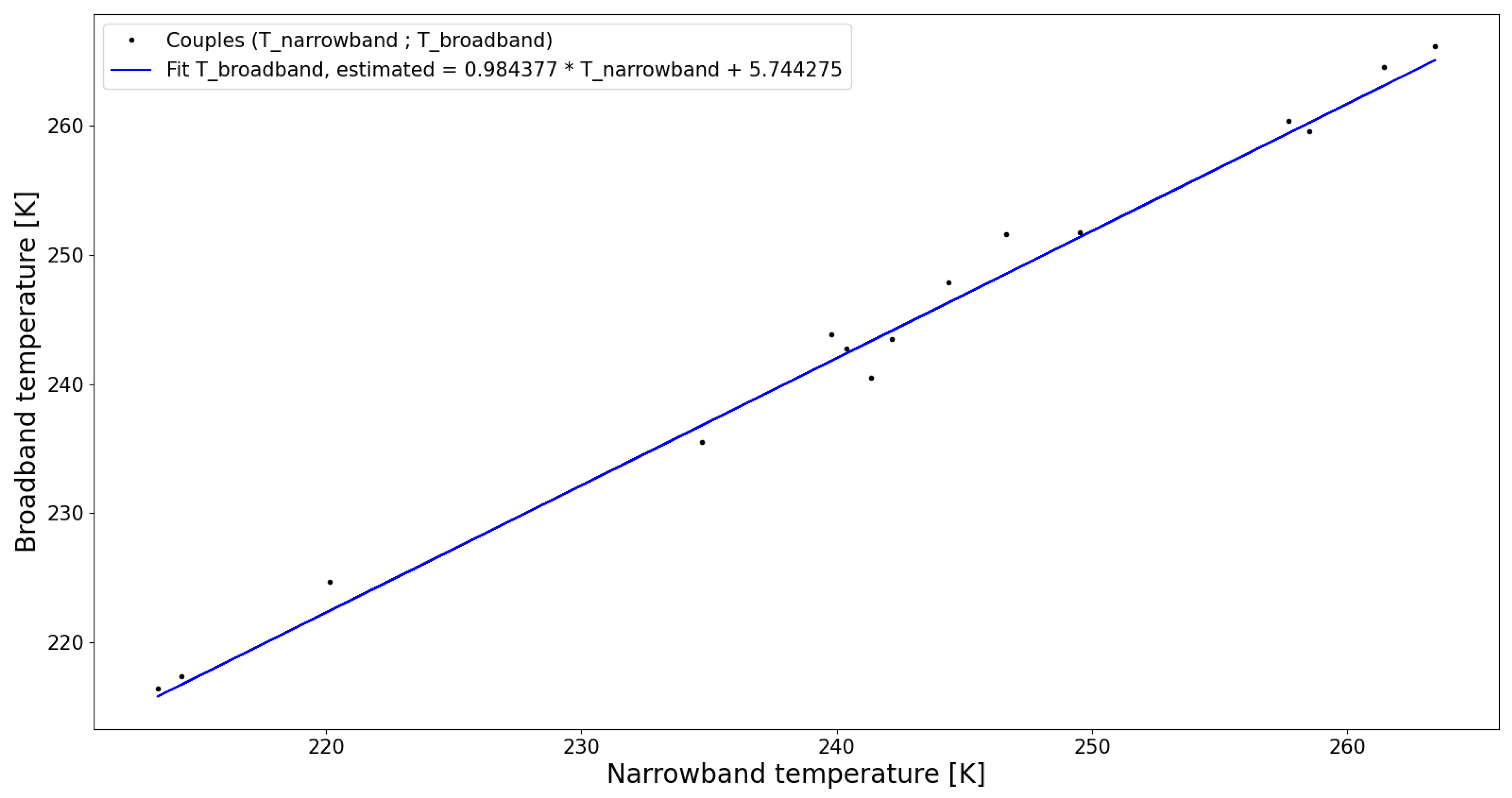
| Front Surface Type | Back Surface Type | Material | Thickness | Diameter | |
|---|---|---|---|---|---|
| 1st lens | Spherical | Spherical | Ge | 4 mm | 32.4 mm |
| 2nd lens | Spherical | Aspherical | Ge | 6 mm | 32.4 mm |
| 3rd lens | Spherical | Spherical | Ge | 6 mm | 27 mm |
| Half FOV (°) | RMS Spot Size (µm) | Airy Disk (=17.28 µm) | |
|---|---|---|---|
| 1st field | 0 | 9.95 | diffraction-limited |
| 2nd field | 5 | 10.55 | diffraction-limited |
| 3rd field | 10 | 12.06 | diffraction-limited |
| 4th field | 15 | 13.88 | diffraction-limited |
| 5th field | 20 | 15.48 | diffraction-limited |
| 6th field | 30 | 16.68 | diffraction-limited |
| 7th field | 40 | 15.19 | diffraction-limited |
| 8th field | 45 | 14.32 | diffraction-limited |
| 9th field | 50 | 13.91 | diffraction-limited |
| 10th field | 60 | 13.83 | diffraction-limited |
| 11th field | 65 | 13.76 | diffraction-limited |
| 12th field | 70 | 14.52 | diffraction-limited |
| Name | Abbreviation |
|---|---|
| U.S. Standard | us |
| Tropical | tr |
| Midlatitude Summer | ms |
| Midlatitude Winter | mw |
| Subarctic Summer | ss |
| Subarctic Winter | sw |
| U.S. Standard with water clouds | us_wc |
| U.S. Standard with thin ice clouds | us_ic_thin |
| U.S. Standard with thick ice clouds | us_ic_thick |
| Midlatitude Winter with water clouds | mw_wc |
| Midlatitude Winter with thin ice clouds | mw_ic_thin |
| Midlatitude Winter with thick ice clouds | mw_ic_thick |
| Subarctic Summer with water clouds | ss_wc |
| Subarctic Summer with thin ice clouds | ss_ic_thin |
| Subarctic Summer with thick ice clouds | ss_ic_thick |
| Scene | Tbroadband [K] | Tnarrowband [K] | OLR [W/m2] | [%] |
|---|---|---|---|---|
| U.S. Standard (us) | 258.51 | 259.56 | 260.21 | −1.01 |
| Tropical (tr) | 263.44 | 266.11 | 265.06 | 1.56 |
| Midlatitude Summer (ms) | 261.41 | 264.52 | 263.07 | 2.16 |
| Midlatitude Winter (mw) | 249.53 | 251.73 | 251.37 | 2.16 |
| Subarctic Summer (ss) | 257.70 | 260.34 | 259.42 | 1.41 |
| Subarctic Winter (sw) | 240.38 | 242.71 | 242.36 | 0.57 |
| U.S. Standard with water clouds (us_wc) | 244.39 | 247.86 | 246.31 | 2.47 |
| U.S. Standard with thin ice clouds (us_ic_thin) | 241.33 | 240.46 | 243.30 | −4.80 |
| U.S. Standard with thick ice clouds (us_ic_thick) | 213.40 | 216.41 | 215.81 | 1.10 |
| Midlatitude Winter with water clouds (mw_wc) | 239.79 | 243.81 | 241.79 | 3.28 |
| Midlatitude Winter with thin ice clouds (mw_ic_thin) | 234.73 | 235.49 | 236.81 | 2.25 |
| Midlatitude Winter with thick ice clouds (mw_ic_thick) | 214.35 | 217.35 | 216.75 | 1.10 |
| Subarctic Summer with water clouds (ss_wc) | 246.63 | 251.60 | 248.52 | 4.80 |
| Subarctic Summer with thin ice clouds (ss_ic_thin) | 242.16 | 243.47 | 244.12 | −1.08 |
| Subarctic Summer with thick ice clouds (ss_ic_thick) | 220.15 | 224.67 | 222.46 | 3.89 |
Publisher’s Note: MDPI stays neutral with regard to jurisdictional claims in published maps and institutional affiliations. |
© 2021 by the authors. Licensee MDPI, Basel, Switzerland. This article is an open access article distributed under the terms and conditions of the Creative Commons Attribution (CC BY) license (https://creativecommons.org/licenses/by/4.0/).
Share and Cite
Schifano, L.; Smeesters, L.; Berghmans, F.; Dewitte, S. Wide-Field-of-View Longwave Camera for the Characterization of the Earth’s Outgoing Longwave Radiation. Sensors 2021, 21, 4444. https://doi.org/10.3390/s21134444
Schifano L, Smeesters L, Berghmans F, Dewitte S. Wide-Field-of-View Longwave Camera for the Characterization of the Earth’s Outgoing Longwave Radiation. Sensors. 2021; 21(13):4444. https://doi.org/10.3390/s21134444
Chicago/Turabian StyleSchifano, Luca, Lien Smeesters, Francis Berghmans, and Steven Dewitte. 2021. "Wide-Field-of-View Longwave Camera for the Characterization of the Earth’s Outgoing Longwave Radiation" Sensors 21, no. 13: 4444. https://doi.org/10.3390/s21134444
APA StyleSchifano, L., Smeesters, L., Berghmans, F., & Dewitte, S. (2021). Wide-Field-of-View Longwave Camera for the Characterization of the Earth’s Outgoing Longwave Radiation. Sensors, 21(13), 4444. https://doi.org/10.3390/s21134444







